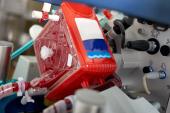After DanGer Shock’s Win in AMICS for Impella: What’s Next?
Interventionalists say it’s now time to make a dent in the complication rate, whether by strict protocols or smaller devices.

Physicians forced to make rapid-fire choices, with limited evidence, in acute myocardial infarction complicated by cardiogenic shock (AMICS) finally have what they’ve long been waiting for: positive data from a randomized clinical trial of the Impella percutaneous left ventricular assist device (Abiomed).
Now, with newly released numbers from the DanGer Shock trial, interventional cardiologists who spoke with TCTMD say they’re inspired by the prospect of a survival benefit in these very sick patients and sobered by the clearer picture they now have of complications that can occur.
As reported by TCTMD, the study, presented at the recent American College of Cardiology (ACC) 2024 Scientific Session and published in the New England Journal of Medicine, showed an absolute mortality reduction of nearly 13% at 180 days with Impella CP compared with standard care (45.8% vs 58.5%; P = 0.04).
But, as investigator Jacob Eifer Møller, MD, PhD, DMSc (Copenhagen University Hospital Rigshospitalet, Denmark), pointed out at the time, this increase in survival “did not come without a cost.” Severe bleeding, limb ischemia, hemolysis, device failure, or worsening aortic regurgitation—the study’s safety endpoint—were, in combination, quadrupled with Impella therapy (24% vs 6.2%).
The delicacy of this trade-off has not gone unnoticed in the weeks following ACC 2024. Even so, the strongest reaction seems to be excitement.
“Finally we have a positive study. I was very happy,” said Alaide Chieffo, MD (Università Vita-Salute San Raffaele and IRCCS San Raffaele Hospital, Milan, Italy), president-elect of the European Association of Percutaneous Cardiovascular Interventions. “Honestly, I was not expecting that because this trial was very complicated to do. In the setting of cardiogenic shock, there are so many variables that can interfere,” she told TCTMD, describing the investigator-driven trial as “really phenomenal work.”
It’s been so long since we’ve had any positive trials in the cardiogenic shock space that we kind of get numb to them and have a nihilistic attitude. David Cohen
William Suh, MD (Corona Regional Medical Center, CA), who years ago started the #RCT4Impella campaign on Twitter to amplify the message that a trial like DanGer Shock was needed, said in an email that the study stands out as what’s likely the most important interventional cardiology trial in the past decade. “Interventional cardiologists around the world who have been using the Impella device can finally breathe a sigh of relief,” he noted, “that what we have been doing for patients with acute MI and cardiogenic shock has in fact been beneficial.”
Duane Pinto, MD (Beth Israel Deaconess Medical Center and JenaValve Technology, Boston, MA), is a longtime user of Impella who spoke with TCTMD for a 2018 feature exploring how clinicians were tasked with weighing what was, at the time, limited real-world data. Hearing the new results, said Pinto, he felt “a sense of relief that it’s finally out there and kind of validating what I had hoped for, which is what I saw clinically in my own experience: that these devices make a difference amongst this population of AMI cardiogenic shock.”
He, too, expressed admiration for the investigators for what proved to be a long journey from vision to completion and “for having been so persistent and believing in something that was a really difficult thing to investigate and complete,” saying, “It is a momentous accomplishment regardless of what the result was.”
“My gut reaction is I was pleasantly surprised,” David Cohen, MD (St. Francis Hospital, Roslyn, NY), agreed. “It’s been so long since we’ve had positive trials in the cardiogenic shock space that we kind of get numb to them and have a nihilistic attitude but it’s wonderful for the field to have some evidence that a therapy that many of us intuitively believe would help these patients does seem to help and help in an important way.”
Threading the Needle
Srihari Naidu, MD (Westchester Medical Center, Valhalla, NY), the vice president of the Society for Cardiovascular Angiography and Interventions (SCAI), led the group’s effort to develop the first-ever classification system for cardiogenic shock. He pointed out that DanGer Shock is the first study that has “threaded the needle in terms of finding a sick enough patient population that is clinically applicable to what we see in practice—the patients that we are concerned about.”
All DanGer Shock patients were in SCAI stage C (Classic), D (Deteriorating), and E (Extremis), and researchers excluded patients with out-of-hospital cardiac arrest (OHCA) who remained comatose after arrival to the cath lab and those with overt RV failure.
“To me, this is a validation that clinical trials will use the definitions to make sure they’re enrolling the appropriate type of patients,” Naidu said.
Importantly, the impact of Impella on survival compared with standard care was big enough to overwhelm its sizeable complication rate, Naidu added. DanGer Shock researchers calculated that the number needed to treat to avoid one death was eight, with a number needed to harm of six.
This is something that “I think people have not really digested,” he said. “We rarely see that reduction in mortality with most things. TAVR had that, but that was a breakthrough: if you put the apples to apples, you have to say that from the death standpoint this is very similar to the TAVR literature in that there’s a marked improvement in mortality, albeit with risks.”
The margins, however, are thin. “It doesn’t take much to shift that balance,” Pinto observed. “And when somebody has a horrible complication, you may erase the mortality benefit, because you’ve traded one bad thing for maybe a worse thing.”
Holger Thiele, MD (Heart Center Leipzig at University of Leipzig, Germany), who led the negative IABP-SHOCK II and ECLS-SHOCK trials testing intra-aortic balloon pump (IABP) and extracorporeal membrane oxygenation (ECMO), respectively, agreed that the absolute reduction in mortality at 6 months is “at first glance impressive.” But, he stressed in an email, “the immediate reflex should not be to implant an Impella in every patient with cardiogenic shock, . . . [as] there are multiple unanswered questions, which hopefully can be explained by further subanalyses of DanGer Shock.”
Not a Blanket Endorsement
Given the delicate balance of risk and benefit, it’s worth remembering that these positive results were obtained by “highly skilled operators who have experience with the device,” said Pinto.
“They know how to manage the people inside the cath lab and the people outside the cath lab to minimize complications and hemolysis. That requires taking your practice seriously as a physician. You need to be able to learn how to use the device properly and get comfortable with large-bore access,” he added, highlighting the acute limb ischemia rate of 5.6% and the moderate/severe bleeding rate of 21.8%.
How the same types of patients would fare in the hands of less experienced physicians is unclear—all the more reason for a team-based approach to cardiogenic shock that involves interventional cardiologists, cardiac surgeons, and intensivists across the continuum of care.
Chieffo argued for centers having a “protocol in place” that addresses things like implantation of the Impella device, management of large-bore access, what should happen in the ICU, and the best approach to escalation of mechanical circulatory support (MCS).
“One of the key messages here,” Cohen concurred, “is this device and this therapy need to be applied in expert hands at sites that are well trained, well qualified, [and] have experience with placing, removing, and managing the device. All of those are very important, and I think that can’t be overstated.”
The immediate reflex should not be to implant an Impella in every patient with cardiogenic shock. Holger Thiele
Naidu also spoke to the complex web of care that AMICS patients require. “It’s not that you need to be afraid of the complications,” he said, as “being aggressive in patients who need you to be aggressive will ultimately improve survival if using this device and this algorithm. The second thing, of course, is you don’t rest on those laurels—you figure out how to reduce those complications.”
He cited meticulous device management before and after the procedure as well as the need for innovation that results in future devices that are “smaller, more facile to place, and more easily stay in over time.” At his hospital, Westchester Medical Center, they frequently reassess SCAI stage as an “ongoing process” to make sure that AMICS patients are progressing in the right direction within 24 hours. If this progress isn’t happening, he said, they “escalate these patients fairly rapidly,” by removing the first Impella that had been inserted in the groin and replacing its support with a more-powerful Impella 5.0 in the axillary artery that can stay in longer with fewer complications.
Impella is a “great tool,” but with 6-month mortality the remains in the ballpark of 46%, “there’s still more work to do,” Pinto said. “Mitigating complications and avoiding what ends up being a spiral of complications when people start having them—bleeding and limb problems—I think that will help.” Beyond this, there’s a need to treat MI patients “sooner and not later in the course of their disorder,” he noted.
Behnam Tehrani, MD (Inova Heart and Vascular Institute, Fairfax, VA), who’s called for an “agnostic” approach to shock care, pointed out that DanGer Shock, though a “big win,” is only the third positive trial in this space in the last 25 years, after SHOCK and CULPRIT-SHOCK. As such, it “needs to be taken in the context that this is not a blanket endorsement of this technology but rather a signal for the need to have really sound patient selection and protocols around device insertion,” he told TCTMD. “It’s important to mention that this trial’s been studied and had a not insignificant fragility index,” meaning that if two deaths had switched from the treatment to the control arm, “then the results would not have been significant.”
Selective Enrollment
Robert Yeh, MD (Beth Israel Deaconess Medical Center), like his peers, commented to TCTMD that despite some caveats, DanGer Shock “will have an enormous impact on the field,” whether by validating what some operators have already been doing or by encouraging wider adoption of percutaneous MCS among those new to using the therapy.
What with the trial’s “very selective” enrollment, said Yeh—just 360 out of 1,211 patients screened—it remains to be seen how real-world practice stacks up against these results.
Thiele shared a similar point: that the mortality reduction shown by DanGer Shock only applies to “a selected group of patients with STEMI and cardiogenic shock who are not at risk of neurological deficit.” This population only accounts for around 20% of real-world patients with infarction-related cardiogenic shock, he added.
Indeed, Cohen believes that careful patient selection is one big reason why DanGer Shock was positive while so many other studies were negative.
“The patients had to have strong objective evidence of ongoing cardiogenic shock and they couldn’t have conditions that couldn’t be treated by the Impella, such as severe RV dysfunction,” he said. “Most importantly, these patients were not in persistent coma after out-of-hospital cardiac arrest. I think that is really fundamental.”
For most patients who remain comatose after OHCA, “their prognosis is determined neurologically and not based on cardiac function, and interventions such as a cardiac assist device like the Impella really are futile in those cases,” Cohen explained. “It very likely does not provide any benefit—and it clearly causes harm—in patients with severe neurologic dysfunction who are unlikely to be salvaged. . . . The negative side of things is equally important as the positive side. We have to take both into account as we think about our patients.”
Other Questions Needing Answers
Thiele, with years of experience in shock research, has additional questions about the findings. For one, while the difference in mortality wasn’t yet seen at 30 days, after that time the rate rose by 11.9% in controls and just 4.9% in the Impella group. “Is this the unloading effect of the left ventricle by the Impella? Unfortunately, although defined as secondary endpoints, the effects on lactate, cardiac power output, and left ventricular ejection fraction have not been published, which is unusual for a publication in the New England Journal of Medicine,” Thiele said.
Moreover, the eventual 6-month death rate in the control arm is “striking,” he noted, compared with the less than 50% mortality in the IABP-SHOCK II and CULPRIT-SHOCK trials, where patients had a risk profile similar to those in DanGer Shock. Even in ECLS-SHOCK, where patients were at higher risk from the get-go, mortality was lower.
Equally conspicuous is the unusually short average ICU stay, Thiele observed, and “also difficult to understand is the very high rate of renal replacement therapy, which was doubled in the Impella arm compared to control [41.9% vs 26.7%] and is the highest rate of renal replacement therapy ever reported in cardiogenic shock (usually in the range of 10-20%).” He said the explanation offered within the NEJM paper—that more patients died in the control arm and thus didn’t receive renal replacement therapy—is undermined by the Kaplan-Meier curves not diverging within the first 15 days, when treatment would be most intensive.
Suh, for his part, drew attention to the DanGer Shock finding that the mortality curves continue to separate out to 6 months. “It raises the possibility that using Impella, especially pre-PCI, may allow for better LV recovery and less chronic heart failure. It sets up the stage for STEMI-DTU, which hopefully will be another positive Impella RCT,” albeit in patients who don’t present with cardiogenic shock, he said.
What About Women?
There’s even more uncertainty as to what DanGer Shock means for women. Female patients made up just 21% of the cohort, and results were lackluster in this group. Analyzed by sex, Impella was linked to significantly lower mortality in men but not in women.
The most plausible explanation, most told TCTMD, is that the number of female patients was simply too small to show any difference. However, as in other cardiovascular conditions, women with AMICS may seek help for symptoms later, experience atypical symptoms, or receive suboptimal treatment—all things that would affect their response to therapies for cardiogenic shock.
Chieffo said that, in her own firsthand experience with the IMP-IT study, she’s seen that women make up a smaller proportion of the AMICS population compared with men. Additionally, they are more apt to present with NSTEMI or myocardial infarction with nonobstructive arteries complicated by cardiogenic shock rather than STEMI complicated by cardiogenic shock. To better understand what’s going on in DanGer Shock will require more granular data, she added.
The larger issue of women being underrepresented “is something that dogs us in clinical trials in cardiology,” Pinto said. In AMICS, where studies are already hard to do, surmounting this imbalance may not be feasible.
“What I will say: just like everything else, women are undertreated and they have more complications, and that’s reflected in the patient population enrolled. It just highlights more that these smaller-bore devices that are coming out, like [from the manufacturers] Magenta and Supira, will help us to reduce complications and still be able to preserve higher flow. That will advantage a number of people, whether they be smaller men or women,” he explained.
Or it’s possible shock manifests a little differently in female patients, added Pinto. Whatever the reason, “nobody who sees a person with [AMICS] is going to say, ‘Oh, it’s a woman, maybe I should be less aggressive.’ We’re not blinded in that way.”
For women, the risk-benefit balance may also be different. Female patients, on the whole, tend to be smaller and have smaller arteries than male patients, which leads to more complications. “It stands to reason that the same sized device in a smaller tube is going to create a relatively bigger hole and more bleeding,” said Pinto, and there’s also the potential for anticoagulant overdosing.
AMICS is one of those instances, not uncommon in interventional cardiology, where the sickest patients are at higher risk of problems but also stand to benefit more from aggressive care, something that can be hard to detect when numbers are small, said Naidu. Women may fall under that category. “I’m very fearful that we oftentimes exclude patients who ultimately have more benefit because of fear of complications. We need to understand that if we’re taking sick patients, complications are a [fact] of life. . . . We have to get them through that and if there’s a mortality benefit, that’s what wins out in the end for the patient.”
Naidu noted that DanGer Shock did not show worse survival with Impella for women, just no benefit, going on to predict that “if you can get rid of the complications in women, you would probably have an even larger benefit. This would have to be proven, but we know that from almost every other interventional technique we do in women, we ultimately 10 years later come around to saying we should’ve been doing it in women all along.”
What Happens Next?
Everyone agreed: for this field to evolve further, it’s time to start to chip away at the complication rate.
Smaller MCS devices would benefit smaller people, including women. “There are several companies, including Abiomed, that are developing and testing smaller devices. The challenge with those devices is the way that they work. So they’re smaller at the groin, that is for sure: they’re substantially smaller,” in the range of 8- to 10-Fr, Cohen said. However, “they’re only being tested in the other [MCS] indication—high-risk PCI—and . . . there are concerns that if they’re left in for a long period of time, they may cause a lot of hemolysis.” This matters because while high-risk PCI requires MCS to be left in only for a few hours, in AMICS, devices are in place for days.
“But I think there’s no question if we could have a smaller-profile device [without causing hemolysis] that could be left in for several days, that would be a major advance and would likely improve the benefit from this therapy,” Cohen confirmed.
DanGer Shock “demonstrated that we still have a significant opportunity to improve outcomes in patients, whether with newer technologies or better treatment and management approaches,” Yeh said, adding he has “hope that smaller devices or devices that cause less hemolysis could be a substantive improvement over existing ones, and further improve outcomes in this incredibly sick population.”
As a next step, Tehrani said, the field should “reflect on the findings and identify the opportunities, and then work through pragmatic, multicenter registries with nested clinical trials to address those areas within the study where there are still opportunities for improvement.”
Then there’s the existing option, IABP therapy, which fell out of favor in Europe after IABP-SHOCK II led to the 2012 downgrade in the European guidelines. DanGer Shock was almost entirely conducted on a backdrop of no IABP.
“Europeans will not criticize the trial for not using the balloon pump, because that’s their standard of care, but on this side of the Atlantic there’s criticism that we still use a lot of balloon pumps,” Naidu said. So, the question lingers as to how IABP would compare to Impella in a trial designed to include SCAI shock standards: this, he added, is an argument for the ongoing US-based RECOVER IV trial.
Despite all the remaining unknowns, every interventionalist interviewed by TCTMD said DanGer Shock’s survival benefit alone is enough to make the trial a huge milestone.
“Back in 2018,” Suh recalled, “TCTMD quoted me saying, ‘I just want proof so that I’m comfortable knowing that the thing that I’m using is of benefit to that particular patient that I’m treating.’ I can now say with confidence, albeit 6 years later, that in a patient with acute MI and cardiogenic shock defined as hypotension, reduced ejection fraction, and elevated lactate, using Impella can reduce the chance of that patient dying. It would be nice to have a second trial replicating these results to confirm the results of DanGer, but I do not think there is equipoise to be able to randomize these patients now that DanGer Shock was positive.”
Indeed, these data may mean RECOVER IV has a hard road ahead, but he said countries like Egypt and India, which don’t yet have Impella available to them, could be places to do a second RCT.
For now, RECOVER IV study chair Gregg Stone, MD (Icahn School of Medicine at Mount Sinai, New York, NY), seems undaunted.
Latest poll: With 800 responses from cardiologists, it appears ~2/3 would be willing to randomize into a trial like RECOVER-IV testing an Impella strategy vs control in STEMI with cardiogenic shock. pic.twitter.com/zywTKTCLNg
— Gregg W. Stone MD (@GreggWStone) April 17, 2024
Caitlin E. Cox is News Editor of TCTMD and Associate Director, Editorial Content at the Cardiovascular Research Foundation. She produces the…
Read Full Bio




Comments